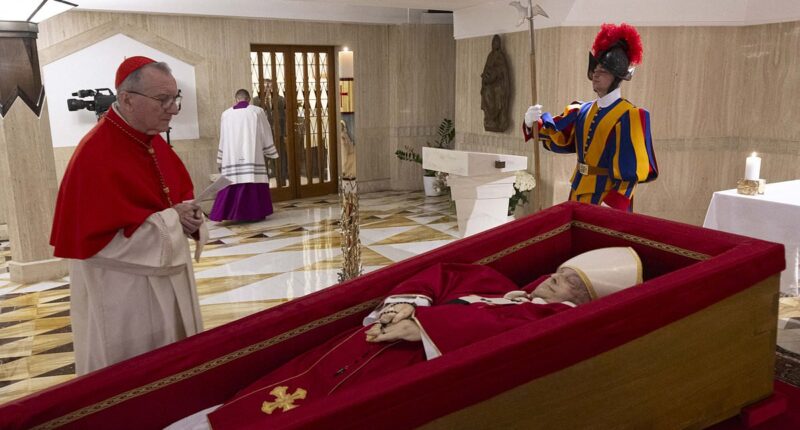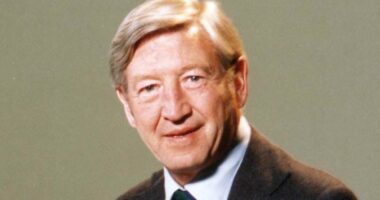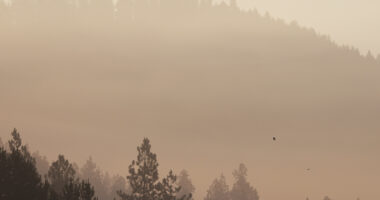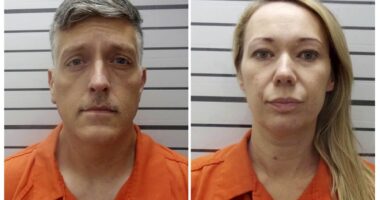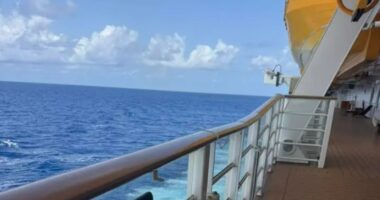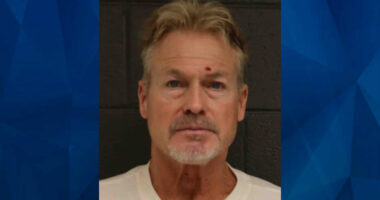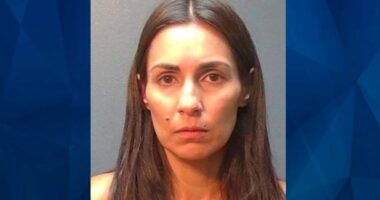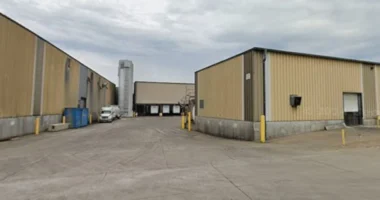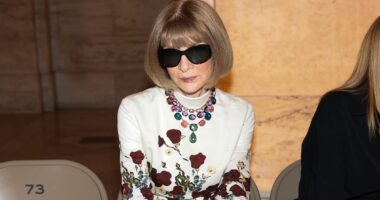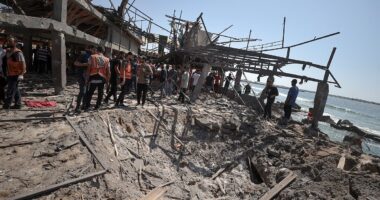The body of Pope Francis has been laid out in open coffin at the Vatican for the Confirmation of the Death of the Pontiff ceremony.
The rite confirming Francis’ death and the placement of his body in the coffin took place last night at the Chapel of Santa Marta, the Vatican has said.
Cardinal Kevin Farrell, the Vatican camerlengo, read the official declaration of death aloud in a ceremony lasting just under an hour.
Seals were also placed on the papal apartment in the Apostolic Palace and on the apartment in Chapel of Santa Marta, where Francis had resided.
Cardinals have assembled at the Vatican this morning to start planning Francis’ funeral and the elaborate rituals marking the end of one papacy and start of the next.
In the coming days, the Congregation of Cardinals will prepare for his burial, plan the conclave to elect his successor and make other decisions about running the Catholic Church.
Francis died yesterday aged 88 after suffering a cerebral stroke that led to a coma and irreversible heart failure. He had been recovering in his apartment after being hospitalised for five weeks with pneumonia.
He made his last public appearance on Sunday, delivering an Easter blessing and making what would be his final greeting to followers from his popemobile, looping around St. Peter’s Square.

The body of Pope Francis has been laid out in open coffin at the Vatican for the Confirmation of the Death of the Pontiff ceremony

Pope Francis in his open coffin during the rite of the Confirmation of the Death of the Pontiff at the Chapel of Santa Marta in The Vatican

On Easter Sunday, the Pope had appeared on the balcony of St Peter’s Basilica to deliver a blessing to 35,000 faithful in St Peter’s Square

Seals are placed on the Apostolic Palace at the Vatican, after the death of Pope Francis

Cardinals queuing in the Sistine Chapel to swear on the Bible to never reveal the secrets of their deliberations before the start of the conclave back in 2013
The Vatican announced that the first meeting of the Congregation of Cardinals, the gathering of the cardinals currently in Rome, would occur at 9am (8am BST) today in the Vatican’s synod hall.
Most immediately, they will determine when his body can be moved into St. Peter’s Basilica for public viewing – which could occur as soon as tomorrow morning.
Under norms approved by Francis last year, his funeral and burial must occur between Friday and Sunday.
The pope’s formal apartments in the Apostolic Palace were sealed yesterday evening, following a centuries-old ritual.
Irish-born Cardinal Kevin Farrell, who as camerlengo had the task of announcing Francis’ death and confirming it once the cause was determined, presided over the ritual.
Francis chose not to live in the palace, though, but in the Domus Santa Marta hotel on the other side of Vatican City.
He died there and his body was transferred to the hotel chapel in the lobby, where a private viewing is being held today for Vatican officials and members of the pontifical household.
In changes made by Francis last year, his body was not placed in three wooden coffins, as it had been for previous popes. Rather, Francis was placed in a simplified wooden coffin with a zinc coffin inside.
Once in St. Peter’s, his coffin will not be put on an elevated bier, but will just be be placed simply facing the pews, with the Pasqual candle nearby.
The burial must take place between the fourth and sixth day after his death, meaning a likely date is Saturday or Sunday.
President Donald Trump has announced he and first lady Melania Trump plan to attend. Argentine President Javier Milei is also expected.

Cardinal Kevin Farrell, who will guide the Church through the coming days in his role as Camerlengo, or chamberlain, announced the pontiff’s death yesterday, saying: ‘Dearest brothers and sisters, with deep sorrow I must announce the death of our Holy Father Francis’

A woman offer prayers in front of a portrait of Pope Francis prior to a requiem mass at the Manila Cathedra in Manila on April 22, 2025
In his final will, Francis confirmed he would be buried at St. Mary Major basilica, which is outside the Vatican and home to his favourite icon of the Virgin Mary.
Francis would go to the basilica to pray before the Byzantine-style painting that features an image of Mary, draped in a blue robe, holding the infant Jesus, who in turn holds a jewelled golden book.
Francis stopped by the basilica on his way home from the Gemelli hospital on March 23, after his 38-day hospital stay, to deliver flowers to be placed before the icon.
He returned April 12 to pray before the Madonna for the last time.
The pontiff’s funeral will be presided over by the dean of the College of Cardinals or, if that is not possible, by the vice dean or another senior cardinal.
The current dean is Italian Cardinal Giovanni Battista Re, 91. The vice dean is Argentine Cardinal Leonardo Sandri, 81.
Re and Farrell, the camerlengo, will have key roles in the coming days as they summon the cardinals and prepare for the conclave to elect Francis’ successor.
After the funeral, there are nine days of official mourning, known as the ‘novendiali.’
During this period, cardinals arrive in Rome to participate in meetings before the conclave to elect the next pope.
To give everyone time to assemble, the conclave must begin 15-20 days after the ‘sede vacante’ – the ‘vacant See’ – is declared, although it can start sooner if the cardinals agree.

Pope Francis died yesterday aged 88 after suffering a cerebral stroke that led to a coma and irreversible heart failure. Francis is pictured is pictured attending the Via Crucis on Copacabana Beach during World Youth Day on July 26, 2013 in Rio de Janeiro, Brazil

Nuns and the Faithful attend a Rosary Prayer for the late Pope Francis in St. Peter’s Square in Vatican City on April 21, 2025
Cardinal-electors will move into the accommodation within the Vatican, shutting out contact with the outside world. Once the conclave begins, they will gather in the Sistine Chapel to vote in secret sessions.
Four rounds of balloting are taken every day until a candidate receives two-thirds of the vote. The result of each ballot is counted aloud and recorded by three cardinals.
If no-one receives the necessary two-thirds of the vote, the ballots are burned in a stove near the chapel with a mixture of chemicals to produce black smoke.
The process can go to multiple rounds with the same people theoretically getting the same number of votes each time as cardinals wait to see who loses support first.
But slowly, cardinals who voted for someone who only received a very small number of votes are likely to add their vote to one of the stronger candidates in the next round.
Factions may be able to make their views known during informal chats between votes, with key parts of Berger’s film showing heated discussions among cardinals in the canteens and cinemas of the Vatican.
When a cardinal receives the necessary two-thirds vote, the dean of the College of Cardinals asks him if he accepts his election.
If he accepts, he chooses a papal name and is dressed in papal vestments before processing out to the balcony of St Peter’s Basilica.
The ballots of the final round are burned in a special stove, with chemicals producing white smoke to signal to the world the election of a new pope.
Black smoke indicates that no pope has been elected, while white smoke indicates that the cardinals have chosen the next head of the Catholic Church.
The senior cardinal deacon announces from the balcony of St Peter’s ‘Habemus Papam’ – ‘We have a pope’ – before the new pope proceeds out and imparts his blessing on the city of Rome and the world.

Cardinals, including the Archbishop of Westminster Cardinal Vincent Nichols, (right) and Cardinal Timothy Radcliffe, (left) from London, will take part in the vote for the next pope. Nichols and Radcliffe are during a press conference in the Throne Room of Archbishop’s House, central London, on Monday
Farrell will carry out the administrative and financial duties of the Holy See until a new pope takes over.
Cardinals, including the Archbishop of Westminster Cardinal Vincent Nichols, and Cardinal Timothy Radcliffe, from London, will take part in the vote for the next pope.
Both aged 79, the pair are just below the cut-off for voting as part of the conclave.
Only cardinals under the age of 80 are eligible to vote in a conclave – they are known as the cardinal electors and their number is limited to 120.
Asked about the next pope at a press conference on Monday, Cardinal Nichols told reporters: ‘He has to be a man of great inner strength, and I think great inner peace.’
He added: ‘I think those inner capacities of closeness to God and peace are the absolute essentials.’
Cardinal Radcliffe said: ‘I think that we always open ourselves to be surprised. All recent popes have been quite different from each other.’
Bells tolled in chapels, churches and cathedrals around the world and flags flew at half staff in Italy, India, Taiwan and the US yesterday after Francis’ death was announced by the Vatican camerlengo.
Soccer matches in Italy and Argentina were suspended in honour of the Argentine pope who was a lifelong fan of the San Lorenzo soccer club.
Tributes poured in from around the world on Monday, including from the King and other world leaders, with many praising the Pope for his advocacy for the marginalised, moral leadership and compassion. The ordinary faithful remembered his simplicity and humanity.
Prime Minister Sir Keir Starmer said Pope Francis had been ‘a Pope for the poor, the downtrodden and the forgotten’.
He was described by the King, whom he met in recent weeks, as someone who had ‘profoundly touched the lives of so many’.
In East Timor, where Francis’ final outdoor Mass drew nearly half of the population last September, President Jose Ramos-Horta praised Francis’ courage.
‘Papa Francisco was a brave man who was not afraid to speak out against the rulers of the world who seek war, but do not want to seek peace,’ Ramos-Horta said.
‘He challenged the powerful to act with justice, called nations to welcome the stranger, and reminded us that our common home – this Earth – is a gift we must protect for future generations,’ said Nigeria’s President Bola Tinubu, who is Muslim.
Nigeria is Africa’s most populous country and has around 30 million Catholics, representing about 14 per cent of the total population.
